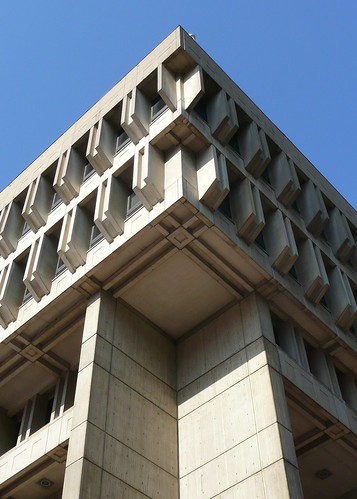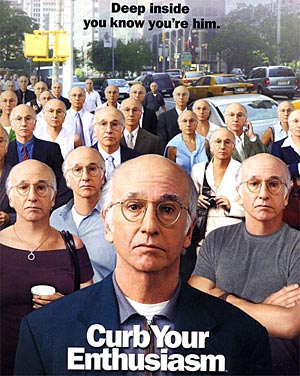“We distrust and have reacted against an architecture that is absolute, uninvolved and abstract. We have moved towards an architecture that is specific and concrete, involving itself with the social and geographic context, the program, and methods of construction, in order to produce a building that exists strongly and irrevocably, rather than an uncommitted abstract structure that could be any place and, therefore, like modern man— without identity or presence.”
– Architect Gehardt Kallmann
In 1962, Kallmann, McKinnell & Knowles won an international competition to design the Boston City Hall. Their bold design broke from the sleek, stylish glass boxes usually associated with the era. Poured-in-place and pre-cast concrete volumes define public space and private space, while breaks and protrusions in the facade allow the public a glimpse inside the mayor's office. The concrete is of the "brutalist" style, a sort of secondary "modernism" which was beginning to crop up around the US and Europe. The Boston City Hall exemplifies this movement through the use of concrete, rough materials and finishes, and large sculptural volumes.
Built elements materialize the concept of government transparency. This building is probably the closest that American Brutalism came to the ethos of movement. The use of "beton brut" concrete expresses and makes clear the construction methods to a broad audience. Concrete is relatively inexpensive, and the technology trumpets "progress". The large, open volumes create a physical and spatial transparency. This civic statement that the building makes formally is strong, successful, and in the spirit of Brutalism. The building could be considered "aloof" (like the government). It is unclear where to enter, and from a distance the functions of the building are not apparent. Volumetrically, the building creates marvelous interior spaces, though taxpayers do not appreciate the subsequent high cost of heating or the wasted space in the building. I believe that Boston City Hall is a wonderful example of civic monumentality and modernist architecture, however as a functioning building it fails miserably.

Upon completion, the building was praised by New York Times architecture critic Ada Louise Huxtable as "a notable achievement ...Old and New Boston are joined through an act of urban design that relates directly to the quality of the city and its life." Huxtable was not the only critic to praise the design. In his survey of Boston architecture, historian Douglass Shand-Tucci called Boston City Hall "one of America's foremost landmarks" and "arguably the great building of twentieth century Boston." These individual sentiments are echoed by architects who, in a 1976 survey, crowned the BCH the sixth greatest building in America. High praise for any building, these accolades are especially provocative in the case of City Hall.
Boston City Hall was recently named "The World's Ugliest Building" in an online poll. The building has been called "ugly", "a bunker," "a heavily muscled, thick-fingered, knuckle-dragging, semi-monstrous intransigent brute with a slow stupid stare," and a prototypical example of "sweater-snagging Brutalism, concrete not friendly to tender fingertips or to the eye." Legend has it that the criticism of City Hall started when the architects unveiled their design. The crowd let out a mixture of cheers, gasps, and a voice that said, "What the hell is that?" Mayor John Collins reportedly let out an inadvertent gasp of horror. (The design had been chosen by four architects and three businessmen, not the mayor.) The building got the last laugh, however, as Collins was so excited to be the first mayor to work in the new city hall that he moved in before the building was complete and he caught pneumonia. He missed his successor's inaugural speech, bedridden.

Walt Lockley, in a lively 2006 critique wonders, "It is interesting to know how this happened, exactly who in 1962 thought this was a good idea, but the much better question is what now?" A Boston Globe article in 2004, asked "Is there a pox on the building?" Mayor Thomas Merino responded, "Cursed? Nah, it's not cursed. C'mon, it's just had a bad beginning. It's a tough building, though, confusing, too much wasted space, expensive to heat, and it's modernistic and not typical of Boston." Merino, however has led a campaign to destroy the building and move government functions to a site in South Boston. He favors the design of a more "aesthetically pleasing" building. A group of activists have formed the "Friends of Boston City Hall" in order to prevent its destruction. Merino embraced the 2008 "Ugliest Building" award as "good for tourism." As of 2011, plans to demolish BCH are on hold. Architect Gehardt Kallman holds out hope. "I get a sense I may live to see City Hall come back into fashion."
The critics range from architects to critics to city workers. Critics love the building, as do architects, though the flaws do not go unnoticed. The public and the people who work in the building hate the building and do not care about the historical or cultural value of it. Ada Louise Huxtable praised the building, as did Douglass Shand-Tucci. The AIA loves it. So why do the city workers and public hate it? It has a grim aesthetic which takes effort to enjoy. Most people do not understand the beauty of raw concrete. Most people are not able to piece together the construction process through the treatment of the concrete. And most importantly, the public doesn't understand the history of this type of building or the futurist-progressive innovation of the material. Their interaction with the building is very limited. The people who work inside the building hate it because it is dark, cold, hard to navigate, and generally uncomfortable. Boston City Hall raises an importan question, whose opinion do we trust in matters of preservation?

The Lockley piece highlights this question. He is knowledgable and has a humorous yet critical tone. (As many critics of BCH have.) The timing and nature of his critique make me wonder what his intentions are. I suspect he is writing this piece as an activist pre-empting the backlash toward Mayor Merino's plan to demolish the building and sell the land to private developers. He says, "So when the City of Boston finally wants to begin public hearings, inevitably some conservationist will file suit to preserve the building...trust your own judgment and the judgment of those who use and work in the building. Those opinions are the ones that count." Whose opinion do we trust in a circumstance like this one? Do we differ to the educated and informed opinion of architects and critics who love the building as a great work of art, a monument to our civilization? Or is the poor functionality of the building, the leaks, drafts, and dim spaces, enough to condemn and destroy? In this case we should leave the building. Many structures with no redeeming qualities have performance issues. BCH has enough significance beyond function that we should leave it be.



































 Hybrid cooler/scooter. This guy is always the life of the party.
Hybrid cooler/scooter. This guy is always the life of the party.












